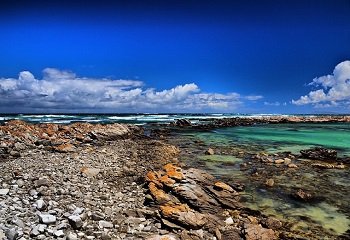See Cape Agulhas the place where two oceans meet
Have you ever consider or thought that there exist a place on Earth where two oceans meet? Yes, there is a place where you can truly put one foot in the Indian Ocean and the other in the Atlantic Ocean, and that place is Cape Agulhas. Let’s talk about it more.

Do you know that when Portuguese explorer Bartolomeu Dias rounded the rocky headland of South Africa’s Cape Peninsula in 1488, he had become the first European to do so, thus opening the way for a sea route from Europe to Asia. He named it the “Cape of Storms” because of the perilous sea, but it was later renamed “Cape of Good Hope”, because it brought hopes of a new route to India. On his return journey, Dias passed another rocky headland but he was unaware that this unimpressive point was the southern extremity of Africa. Many people still believe that Cape of Good Hope is the southern-most tip of the African continent but that title belongs to Cape Aqulhas – the inconspicuous rocky headland about 150 km further south. Incidentally, Cape Agulhas is also the place where the official dividing line between the Atlantic and Indian Oceans passes. A stone plaque on the beach marks the place.
Do you know that the boundary was not arbitrarily chosen? This is the place where the warm-water Agulhas current of the Indian Ocean meets the cold water Benguela current of the Atlantic Ocean and turns back on itself.
However, any physical definition of a meeting point or dividing line between two oceans ignores the fact that current don’t just halt their flow at any point. Ocean currents shift and mingle.
Cape Agulhas was named by the Portuguese navigators, who called it Cabo das Agulhas, Portuguese for ‘Cape of Needles’, because they noticed that the compass needle, hence the direction of the magnetic north, coincided with true north in that area. The Earth’s magnetic north pole, however, shift slowly with time, thus changing magnetic declination values throughout the world accordingly. The declination around the cape today is 25 degree west, which means that the magnetic north pole lies 25 degree to the left of true north.
TRENDING NOW: PUTIN SAYS JESUS AND MARY WERE BLACK -SEE VIDEO
Where then is Cape Agulhas?
Cape Agulhas is the southernmost part of South Africa. It is approximately 50 km south of Cape Town. It is a rocky headland in Western Cape, South Africa. It is the geographic southern tip of Africa and the beginning of the traditional dividing line between the Atlantic and the Indian Oceans according to the International Hydrographic Organization. It is approximately half a degree of latitude, or 55 kilometers (34mi), further south than the Cape of Good Hope.
Historically, the cape has been known to sailors as a major hazard on the traditional clipper route. It is sometimes regarded as one of the great capes. The town of L’Agulhas is near the Cape!
Where the Indian and Atlantic Oceans actually meet have been the topic of many heated arguments among South African and many explorers. The root of this confusion is that the point at which the Agulhas current meets the Benguela current tends to fluctuate seasonally between Cape Agulhas and Cape Point, about 1.2 km east of the Cape of Good Hope. Nevertheless, Cape Agulhas is the meeting point where the Indian and Atlantic Oceans meet at the Southern part of Africa.
Do the Pacific and Atlantic Oceans also meet and Mix?
This is another topic to look into but the Pacific and Atlantic Oceans do mix and are not separate. While we have given our plant’s oceans separate names, in reality there’s no border between them and currents continually flow between them and mix their waters.
Still, each of the planet’s ocean and seas has its own characteristics. For example, the surface salinity of the Atlantic is higher than the Pacific and Indian Oceans, while the enclosed waters of the Red Sea and the Mediterranean are saltier still.
This is because lower salinity water from the deep sea cannot easily flow in, and water evaporates faster than rainfall can replace it.
Do the Indian and Atlantic Oceans actually meet?
Indeed that answer is yes. This is a place where you can put your one foot in the Indian Ocean and the other in the Atlantic Ocean – at the same time!
Although there is a lot of debate around it, this is technically the dividing line along the meridian of 20 degree east to Cape Agulhas where the oceans meet kilometers into the ocean.
Spread the Word: if you found this article useful, help others discover it too! Just click and share using the buttons below!
What's Your Reaction?




















